Detection and Quantification of Cracking in Concrete Aggregate through Virtual Data Fusion of X-Ray Computed Tomography Images
Abstract
1. Introduction
1.1. Alkali-Silica Reaction (ASR)
1.2. X-Ray Computed Tomography (CT)
1.3. Crack Detection and Quantification
2. Materials and Methods
2.1. Sample Selection
2.2. CT Scanning
2.3. Image Analysis
2.3.1. Data Fusion Approach
2.3.2. Implementation
Module 1: Identification of Objects with Low Density
Module 2: Identification of Objects with High Gradient
Module 3: Identification of Objects above a Given Size
3. Results
4. Discussion and Conclusions
Author Contributions
Funding
Acknowledgments
Conflicts of Interest
Appendix A. Visualization of Individual Grains
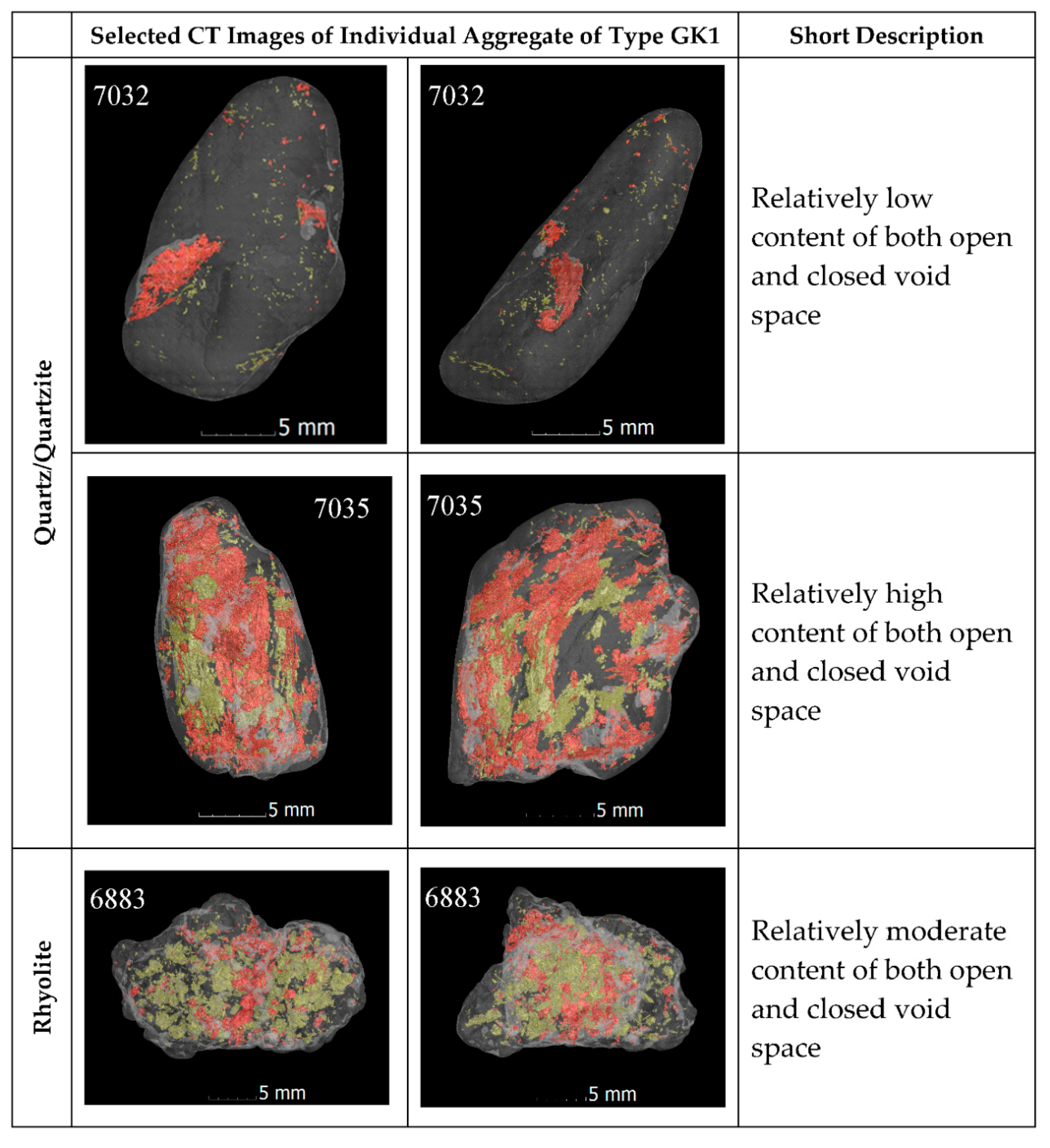
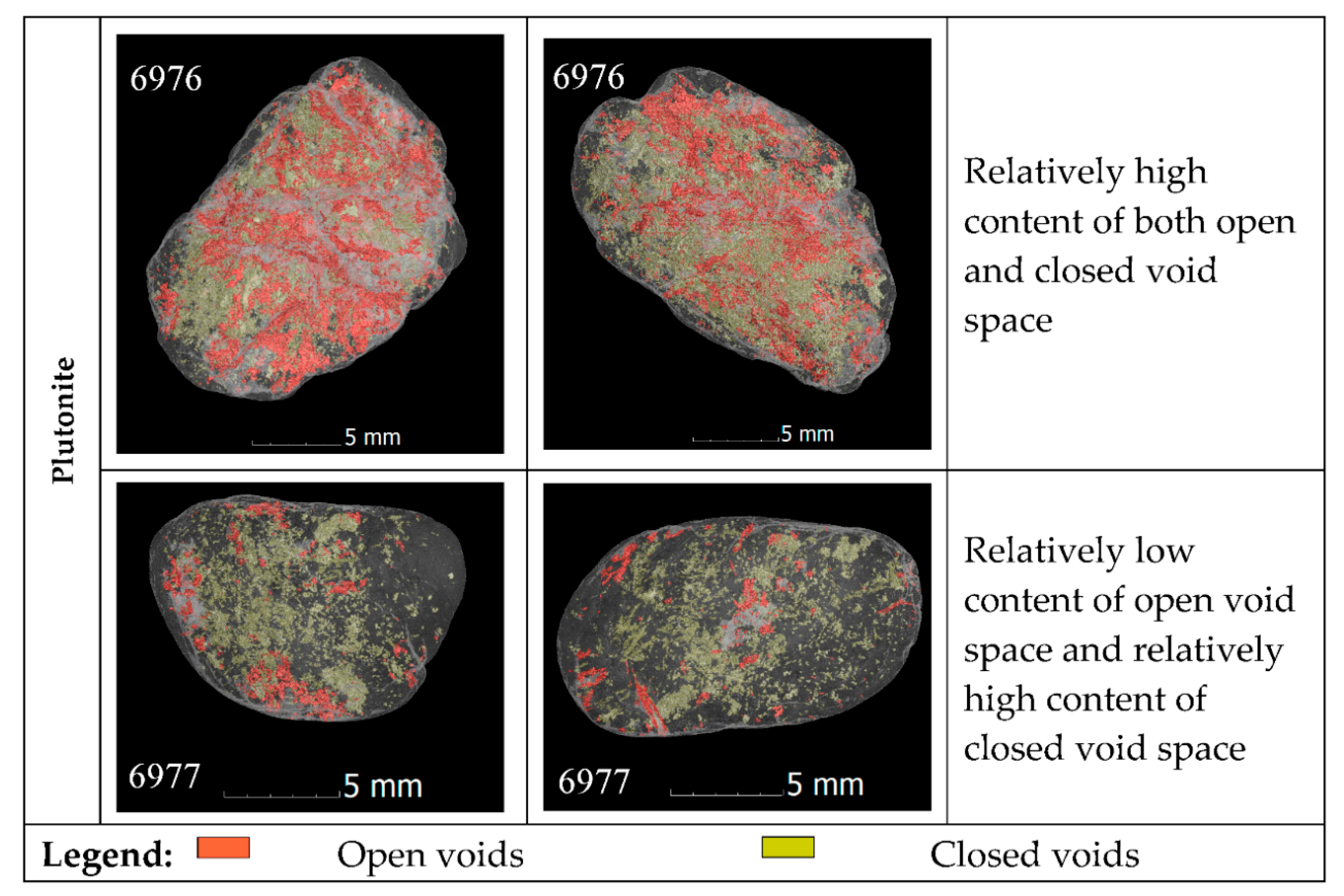


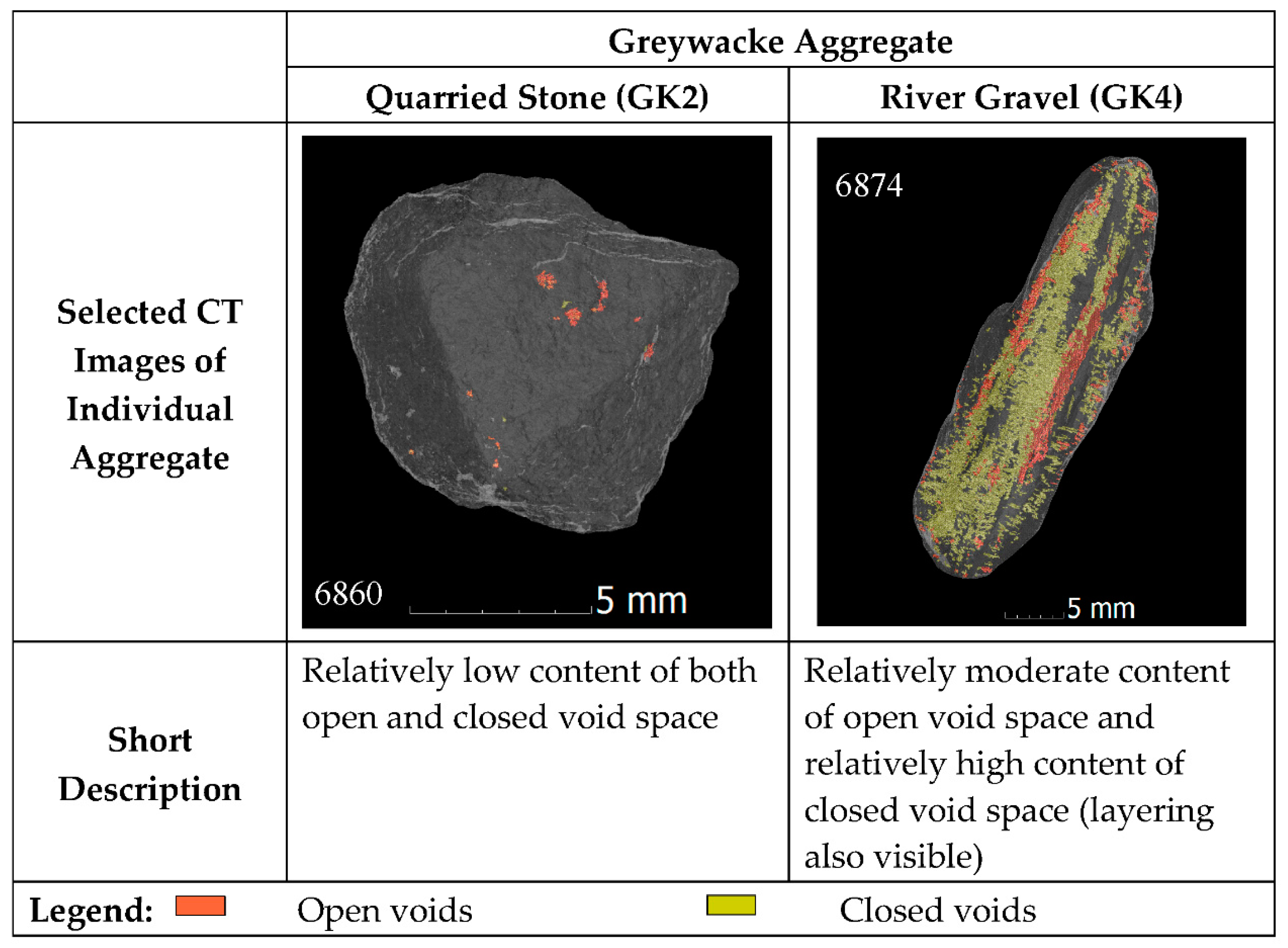

Appendix B. Tabulated Results of Cracking Analysis
| Stone Type | Mass of the Individual Grain [g] | CT Scan Number | Voxel Size [µm] | Surface Areas Measured Using CT [m2] | ||||
|---|---|---|---|---|---|---|---|---|
| Closed Porosity | Outer Surface | Open Porosity | Outer Surface + Open Porosity | |||||
| Absolute [m2] | Relative [m2/g] | |||||||
| Quartz/Quartzite | 3.37 | 7030 | 16.5 | 5.69 × 10−4 | 2.17 × 10−3 | 2.20 × 10−5 | 2.18 × 10−3 | 6.47 × 10−4 |
| 4.49 | 7031 | 1.42 × 10−4 | 1.10 × 10−3 | 6.20 × 10−5 | 1.12 × 10−3 | 2.49 × 10−4 | ||
| 2.89 | 7032 | 3.85 × 10−5 | 1.44 × 10−3 | 9.65 × 10−5 | 1.47 × 10−3 | 5.09 × 10−4 | ||
| 5.63 | 7033 | 3.94 × 10−6 | 9.50 × 10−4 | 1.43 × 10−6 | 9.50 × 10−4 | 1.69 × 10−4 | ||
| 6.26 | 7034 | 1.10 × 10−3 | 1.55 × 10−3 | 1.46 × 10−4 | 1.57 × 10−3 | 2.51 × 10−4 | ||
| 8.04 | 7035 | 9.13 × 10−4 | 2.39 × 10−3 | 3.24 × 10−3 | 2.79 × 10−3 | 3.47 × 10−4 | ||
| 7.33 | 7036 | 2.62 × 10−4 | 1.95 × 10−3 | 1.88 × 10−4 | 1.97 × 10−3 | 2.69 × 10−4 | ||
| 8.32 | 7037 | 2.33 × 10−3 | 2.38 × 10−3 | 8.53 × 10−4 | 2.48 × 10−3 | 2.98 × 10−4 | ||
| 6.50 | 7038 | 3.64 × 10−5 | 1.84 × 10−3 | 2.89 × 10−6 | 1.84 × 10−3 | 2.83 × 10−4 | ||
| 11.17 | 7039 | 3.10 × 10−4 | 2.09 × 10−3 | 3.71 × 10−4 | 2.13 × 10−3 | 1.91 × 10−4 | ||
| Mean | 5.71 × 10−4 | 1.79 × 10−3 | 4.98 × 10−4 | 1.85 × 10−3 | 3.21 × 10−4 | |||
| Standard Deviation | 6.88 × 10−4 | 4.82 × 10−4 | 9.46 × 10−4 | 5.52 × 10−4 | 1.40 × 10−4 | |||
| Rhyolite | 0.77 | 6880 | 11.2 | 0.00 | 5.18 × 10−4 | 0.00 | 5.18 × 10−4 | 6.73 × 10−4 |
| 0.74 | 6881 | 8.60 × 10−6 | 4.87 × 10−4 | 1.71 × 10−6 | 4.88 × 10−4 | 6.60 × 10−4 | ||
| 1.27 | 6882 | 1.59 × 10−4 | 7.50 × 10−4 | 7.07 × 10−5 | 8.21 × 10−4 | 6.47 × 10−4 | ||
| 1.24 | 6883 | 6.55 × 10−4 | 9.78 × 10−4 | 4.87 × 10−4 | 1.46 × 10−3 | 1.18 × 10−3 | ||
| 1.96 | 6884 | 9.57 × 10−6 | 8.32 × 10−4 | 1.49 × 10−5 | 8.47 × 10−4 | 4.32 × 10−4 | ||
| 1.16 | 6885 | 1.30 × 10−6 | 5.65 × 10−4 | 1.33 × 10−6 | 5.67 × 10−4 | 4.89 × 10−4 | ||
| 2.90 | 6886 | 8.63 × 10−5 | 1.21 × 10−3 | 3.28 × 10−5 | 1.25 × 10−3 | 4.30 × 10−4 | ||
| 2.74 | 6887 | 1.79 × 10−4 | 1.20 × 10−3 | 3.35 × 10−5 | 1.24 × 10−3 | 4.52 × 10−4 | ||
| 2.85 | 6888 | 3.67 × 10−5 | 1.03 × 10−3 | 1.80 × 10−5 | 1.05 × 10−3 | 3.68 × 10−4 | ||
| 5.70 | 6889 | 6.38 × 10−5 | 1.62 × 10−3 | 3.81 × 10−6 | 1.62 × 10−3 | 2.85 × 10−4 | ||
| Mean | 1.20 × 10−4 | 9.20 × 10−4 | 6.64 × 10−5 | 9.86 × 10−4 | 5.62 × 10−4 | |||
| Standard Deviation | 1.89 × 10−4 | 3.44 × 10−4 | 1.42 × 10−4 | 3.82 × 10−4 | 2.41 × 10−4 | |||
| Plutonite | 2.43 | 6970 | 11.2 | 1.21 × 10−4 | 9.24 × 10−4 | 1.17 × 10−5 | 9.35 × 10−4 | 3.85 × 10−4 |
| 1.50 | 6971 | 1.57 × 10−4 | 9.03 × 10−4 | 3.64 × 10−4 | 1.27 × 10−3 | 8.44 × 10−4 | ||
| 1.62 | 6972 | 4.53 × 10−5 | 6.74 × 10−4 | 9.49 × 10−6 | 6.84 × 10−4 | 4.22 × 10−4 | ||
| 2.09 | 6973 | 2.12 × 10−4 | 4.72 × 10−3 | 9.71 × 10−4 | 5.69 × 10−3 | 2.72 × 10−3 | ||
| 2.67 | 6974 | 1.23 × 10−3 | 1.07 × 10−3 | 2.26 × 10−4 | 1.30 × 10−3 | 4.87 × 10−4 | ||
| 1.96 | 6975 | 3.46 × 10−4 | 8.53 × 10−4 | 1.02 × 10−4 | 9.54 × 10−4 | 4.87 × 10−4 | ||
| 5.58 | 6976 | 1.66 × 10−3 | 3.43 × 10−3 | 2.35 × 10−3 | 5.79 × 10−3 | 1.04 × 10−3 | ||
| 2.47 | 6977 | 3.58 × 10−4 | 1.00 × 10−3 | 7.83 × 10−5 | 1.08 × 10−3 | 4.38 × 10−4 | ||
| 4.08 | 6978 | 7.40 × 10−4 | 1.65 × 10−3 | 2.67 × 10−4 | 1.91 × 10−3 | 4.69 × 10−4 | ||
| 4.44 | 6979 | 0.00 | 1.24 × 10−3 | 9.91 × 10−8 | 1.24 × 10−3 | 2.79 × 10−4 | ||
| Mean | 4.86 × 10−4 | 1.65 × 10−3 | 4.38 × 10−4 | 2.08 × 10−3 | 7.57 × 10−4 | |||
| Standard Deviation | 5.27 × 10−4 | 1.27 × 10−3 | 6.95 × 10−4 | 1.85 × 10−3 | 6.89 × 10−4 | |||
| Stone Type | Mass of the Individual Grain [g] | CT Scan Number | Voxel Size [µm] | Surface Areas Measured Using CT [m2] | ||||
|---|---|---|---|---|---|---|---|---|
| Closed Porosity | Outer Surface | Open Porosity | Outer Surface + Open Porosity | |||||
| Absolute [m2] | Relative [m2/g] | |||||||
| Greywacke | 1.03 | 6860 | 11.2 | 2.94 × 10−7 | 5.31 × 10−4 | 2.67 × 10−6 | 5.34 × 10−4 | 5.18 × 10−4 |
| 1.12 | 6861 | 5.87 × 10−8 | 6.23 × 10−4 | 0.00 | 6.23 × 10−4 | 5.56 × 10−4 | ||
| 0.66 | 6862 | 7.67 × 10−7 | 4.74 × 10−4 | 8.48 × 10−7 | 4.74 × 10−4 | 7.19 × 10−4 | ||
| 2.23 | 6863 | 2.59 × 10−7 | 9.14 × 10−4 | 5.49 × 10−7 | 9.15 × 10−4 | 4.10 × 10−4 | ||
| 2.04 | 6864 | 0.00 | 9.55 × 10−4 | 3.03 × 10−7 | 9.55 × 10−4 | 4.68 × 10−4 | ||
| 1.9 | 6865 | 0.00 | 9.78 × 10−4 | 1.72 × 10−6 | 9.80 × 10−4 | 5.16 × 10−4 | ||
| 1.39 | 6866 | 1.14 × 10−7 | 7.21 × 10−4 | 0.00 | 7.21 × 10−4 | 5.19 × 10−4 | ||
| 1.08 | 6867 | 0.00 | 7.26 × 10−4 | 1.48 × 10−7 | 7.26 × 10−4 | 6.72 × 10−4 | ||
| 2.11 | 6868 | 9.99 × 10−8 | 1.03 × 10−3 | 6.28 × 10−7 | 1.03 × 10−3 | 4.87 × 10−4 | ||
| 3.98 | 6869 | 4.92 × 10−8 | 1.61 × 10−3 | 1.21 × 10−6 | 1.61 × 10−3 | 4.04 × 10−4 | ||
| Mean | 1.64 × 10−7 | 8.56 × 10−4 | 8.07 × 10−7 | 8.57 × 10−4 | 5.27 × 10−4 | |||
| Standard Deviation | 2.24 × 10−7 | 3.11 × 10−4 | 8.09 × 10−7 | 3.11 × 10−4 | 9.63 × 10−5 | |||
| Stone Type | Mass of the Individual Grain [g] | CT Scan Number | Voxel Size [µm] | Surface Areas Measured Using CT [m2] | ||||
|---|---|---|---|---|---|---|---|---|
| Closed Porosity | Outer Surface | Open Porosity | Outer Surface + Open Porosity | |||||
| Absolute [m2] | Relative [m2/g] | |||||||
| Rhyolite | 1.53 | 6890 | 16.5 | 5.14 × 10−6 | 9.00 × 10−4 | 1.86 × 10−5 | 9.18 × 10−4 | 6.00 × 10−4 |
| 1.66 | 6891 | 4.52 × 10−7 | 9.12 × 10−4 | 8.54 × 10−6 | 9.21 × 10−4 | 5.55 × 10−4 | ||
| 2.68 | 6892 | 6.18 × 10−6 | 1.32 × 10−3 | 4.16 × 10−5 | 1.36 × 10−3 | 5.07 × 10−4 | ||
| 2.56 | 6893 | 6.92 × 10−6 | 1.13 × 10−3 | 2.93 × 10−5 | 1.16 × 10−3 | 4.52 × 10−4 | ||
| 2.89 | 6894 | 1.36 × 10−7 | 1.30 × 10−3 | 1.24 × 10−5 | 1.32 × 10−3 | 4.56 × 10−4 | ||
| 3.08 | 6895 | 4.42 × 10−6 | 1.24 × 10−3 | 6.88 × 10−6 | 1.25 × 10−3 | 4.05 × 10−4 | ||
| 5.18 | 6896 | 7.97 × 10−7 | 1.97 × 10−3 | 6.97 × 10−6 | 1.98 × 10−3 | 3.82 × 10−4 | ||
| 3.44 | 6897 | 9.38 × 10−6 | 1.42 × 10−3 | 2.21 × 10−5 | 1.44 × 10−3 | 4.19 × 10−4 | ||
| 5.07 | 6898 | 1.44 × 10−6 | 1.96 × 10−3 | 6.57 × 10−6 | 1.96 × 10−3 | 3.87 × 10−4 | ||
| 3.47 | 6899 | 8.69 × 10−7 | 1.50 × 10−3 | 3.59 × 10−6 | 1.50 × 10−3 | 4.32 × 10−4 | ||
| Mean | 3.57 × 10−6 | 1.36 × 10−3 | 1.57 × 10−5 | 1.38 × 10−3 | 4.59 × 10−4 | |||
| Standard Deviation | 3.10 × 10−6 | 3.52 × 10−4 | 1.16 × 10−5 | 3.48 × 10−4 | 6.92 × 10−5 | |||
| Stone Type | Mass of the Individual Grain [g] | CT Scan Number | Voxel Size [µm] | Surface Areas Measured Using CT [m2] | ||||
|---|---|---|---|---|---|---|---|---|
| Closed Porosity | Outer Surface | Open Porosity | Outer Surface + Open Porosity | |||||
| Absolute [m2] | Relative [m2/g] | |||||||
| Sandstone | 0.84 | 6980 | 21.1 | 0.00 | 5.67 × 10−4 | 0.00 | 5.67 × 10−4 | 6.75 × 10−4 |
| 1.95 | 6981 | 0.00 | 7.24 × 10−4 | 0.00 | 7.24 × 10−4 | 3.71 × 10−4 | ||
| 1.35 | 6982 | 1.06 × 10−5 | 6.95 × 10−4 | 8.69 × 10−6 | 7.03 × 10−4 | 5.21 × 10−4 | ||
| 3.63 | 6983 | 5.04 × 10−6 | 1.07 × 10−3 | 2.26 × 10−7 | 1.07 × 10−3 | 2.96 × 10−4 | ||
| 3.35 | 6984 | 7.44 × 10−5 | 1.28 × 10−3 | 5.34 × 10−4 | 1.82 × 10−3 | 5.42 × 10−4 | ||
| 4.19 | 6985 | 7.09 × 10−5 | 1.56 × 10−3 | 1.09 × 10−4 | 1.67 × 10−3 | 4.00 × 10−4 | ||
| 4.78 | 6986 | 1.01 × 10−3 | 1.42 × 10−3 | 4.23 × 10−5 | 1.47 × 10−3 | 3.07 × 10−4 | ||
| 5.28 | 6987 | 3.25 × 10−4 | 1.66 × 10−3 | 2.01 × 10−5 | 1.68 × 10−3 | 3.18 × 10−4 | ||
| 6.26 | 6988 | 1.80 × 10−4 | 1.91 × 10−3 | 4.91 × 10−5 | 1.95 × 10−3 | 3.12 × 10−4 | ||
| 8.3 | 6989 | 3.80 × 10−4 | 2.20 × 10−3 | 1.59 × 10−5 | 2.21 × 10−3 | 2.67 × 10−4 | ||
| Mean | 2.05 × 10−4 | 1.31 × 10−3 | 7.79 × 10−5 | 1.39 × 10−3 | 4.01 × 10−4 | |||
| Standard Deviation | 2.97 × 10−4 | 5.17 × 10−4 | 1.55 × 10−4 | 5.52 × 10−4 | 1.28 × 10−4 | |||
| Mudstone | 3.6 | 6960 | 21.1 | 1.72 × 10−4 | 1.30 × 10−3 | 2.56 × 10−5 | 1.33 × 10−3 | 3.68 × 10−4 |
| 1.59 | 6961 | 4.28 × 10−7 | 7.14 × 10−4 | 9.34 × 10−7 | 7.15 × 10−4 | 4.49 × 10−4 | ||
| 1.61 | 6962 | 5.36 × 10−5 | 9.01 × 10−4 | 5.17 × 10−4 | 1.42 × 10−3 | 8.81 × 10−4 | ||
| 3.27 | 6963 | 0.00 | 1.15 × 10−3 | 1.26 × 10−6 | 1.15 × 10−3 | 3.51 × 10−4 | ||
| 1.13 | 6964 | 0.00 | 1.45 × 10−3 | 0.00 | 1.45 × 10−3 | 1.28 × 10−3 | ||
| 2.78 | 6965 | 7.04 × 10−4 | 1.02 × 10−3 | 4.66 × 10−4 | 1.49 × 10−3 | 5.36 × 10−4 | ||
| 2.39 | 6966 | 4.35 × 10−6 | 8.54 × 10−4 | 0.00 | 8.54 × 10−4 | 3.57 × 10−4 | ||
| 2.63 | 6967 | 2.16 × 10−4 | 1.12 × 10−3 | 4.55 × 10−5 | 1.16 × 10−3 | 4.42 × 10−4 | ||
| 4.34 | 6968 | 0.00 | 1.70 × 10−3 | 8.01 × 10−7 | 1.70 × 10−3 | 3.93 × 10−4 | ||
| 2.51 | 6969 | 1.13 × 10−5 | 1.06 × 10−3 | 1.56 × 10−6 | 1.06 × 10−3 | 4.23 × 10−4 | ||
| Mean | 1.16 × 10−4 | 1.13 × 10−3 | 1.06 × 10−4 | 1.23 × 10−3 | 5.48 × 10−4 | |||
| Standard Deviation | 2.10 × 10−4 | 2.79 × 10−4 | 1.94 × 10−4 | 2.88 × 10−4 | 2.86 × 10−4 | |||
| Greywacke | 8.19 | 6870 | 16.5 | 5.61 × 10−4 | 2.33 × 10−3 | 1.25 × 10−4 | 2.46 × 10−3 | 3.00 × 10−4 |
| 5.28 | 6871 | 6.17 × 10−5 | 1.99 × 10−3 | 3.93 × 10−5 | 2.03 × 10−3 | 3.84 × 10−4 | ||
| 8.67 | 6872 | 5.56 × 10−4 | 2.70 × 10−3 | 3.04 × 10−4 | 3.01 × 10−3 | 3.47 × 10−4 | ||
| 5.99 | 6873 | 1.71 × 10−6 | 3.13 × 10−3 | 3.88 × 10−5 | 3.17 × 10−3 | 5.29 × 10−4 | ||
| 4.89 | 6874 | 1.68 × 10−3 | 1.69 × 10−3 | 4.92 × 10−4 | 2.18 × 10−3 | 4.46 × 10−4 | ||
| 2.61 | 6875 | 3.26 × 10−6 | 1.43 × 10−3 | 4.02 × 10−6 | 1.44 × 10−3 | 5.50 × 10−4 | ||
| 6.3 | 6876 | 7.10 × 10−4 | 2.16 × 10−3 | 1.11 × 10−4 | 2.27 × 10−3 | 3.61 × 10−4 | ||
| 3.86 | 6877 | 8.41 × 10−5 | 1.51 × 10−3 | 7.54 × 10−6 | 1.51 × 10−3 | 3.92 × 10−4 | ||
| 3.09 | 6878 | 4.12 × 10−4 | 2.31 × 10−3 | 2.89 × 10−4 | 2.60 × 10−3 | 8.41 × 10−4 | ||
| 2.63 | 6879 | 9.88 × 10−6 | 1.24 × 10−3 | 2.88 × 10−6 | 1.24 × 10−3 | 4.72 × 10−4 | ||
| Mean | 4.08 × 10−4 | 2.05 × 10−3 | 1.41 × 10−4 | 2.19 × 10−3 | 4.62 × 10−4 | |||
| Standard Deviation | 4.96 × 10−4 | 5.68 × 10−4 | 1.58 × 10−4 | 6.19 × 10−4 | 1.47 × 10−4 | |||
| Granite | 1.53 | 6950 | 11.2 | 2.14 × 10−5 | 8.15 × 10−4 | 6.23 × 10−5 | 8.77 × 10−4 | 5.74 × 10−4 |
| 0.72 | 6951 | 1.58 × 10−6 | 5.08 × 10−4 | 1.41 × 10−5 | 5.22 × 10−4 | 7.26 × 10−4 | ||
| 1.09 | 6952 | 3.63 × 10−5 | 6.80 × 10−4 | 1.84 × 10−4 | 8.64 × 10−4 | 7.93 × 10−4 | ||
| 0.98 | 6953 | 1.17 × 10−5 | 5.76 × 10−4 | 5.53 × 10−5 | 6.31 × 10−4 | 6.44 × 10−4 | ||
| 1.92 | 6954 | 1.01 × 10−6 | 8.71 × 10−4 | 1.59 × 10−5 | 8.87 × 10−4 | 4.62 × 10−4 | ||
| 1.76 | 6955 | 7.23 × 10−5 | 9.39 × 10−4 | 6.90 × 10−5 | 1.01 × 10−3 | 5.73 × 10−4 | ||
| 3.17 | 6956 | 1.36 × 10−4 | 1.43 × 10−3 | 3.65 × 10−4 | 1.80 × 10−3 | 5.68 × 10−4 | ||
| 2.77 | 6957 | 1.37 × 10−4 | 1.28 × 10−3 | 5.26 × 10−4 | 1.81 × 10−3 | 6.53 × 10−4 | ||
| 2.69 | 6958 | 4.95 × 10−5 | 1.62 × 10−3 | 5.91 × 10−5 | 1.67 × 10−3 | 6.23 × 10−4 | ||
| 6.15 | 6959 | 1.09 × 10−4 | 1.87 × 10−3 | 9.91 × 10−8 | 1.87 × 10−3 | 3.04 × 10−4 | ||
| Mean | 5.76 × 10−5 | 1.06 × 10−3 | 1.35 × 10−4 | 1.19 × 10−3 | 5.92 × 10−4 | |||
| Standard Deviation | 5.06 × 10−5 | 4.42 × 10−4 | 1.66 × 10−4 | 5.04 × 10−4 | 1.29 × 10−4 | |||
References
- Stanton, T. Expansion of Concrete Through Reaction Between Cement and Aggregate. Proc. Am. Soc. Civ. Eng. 1940, 66, 1781–1812. [Google Scholar]
- Powers, T.; Steinour, H. An Interpretation of Some Published Researches on the Alkali-Aggregate Reaction Part 1—The Chemical Reactions and Mechanism of Expansion. J. Am. Concr. I 1955, 26, 497–516. [Google Scholar]
- Powers, T.; Steinour, H. An Interpretation of Some Published Researches on the Alkali-Aggregate Reaction Part 2—A Hypothesis Concerning Safe and Unsafe Reactions with Reactive Silica in Concrete. J. Am. Concr. I 1955, 51, 785–812. [Google Scholar]
- Locher, F.; Sprung, S. Ursache und Wirkungsweise der Alkalireaktion; Betontechnische Berichte; Forschungsinstitut der Zementindustrie: Düsseldorf, Germany, 1973; pp. 101–123. [Google Scholar]
- Chatterji, S.; Thaulow, N.; Jensen, A. Studies of alkali-silica-reaction. Part 5. Verification of a newly proposed reaction mechanism. Cem. Concr. Res. 1989, 19, 177–183. [Google Scholar] [CrossRef]
- Chatterji, S.; Thaulow, N.; Jensen, A. Studies of alkali-silica-reaction. Part 6. Practical implications of a proposed reaction mechanism. Cem. Concr. Res. 1988, 18, 363–366. [Google Scholar] [CrossRef]
- Stark, J.; Erfurt, D.; Freyburg, E.; Giebson, C.; Seyfarth, K.; Wicht, B. Alkali-Kieselsäure-Reaktion; F. A. Finger-Instituts für Baustoffkunde: Weimar, Germany, 2008. [Google Scholar]
- Thomas, M.D.A.; Fournier, B.; Folliard, K.J. Alkali-Aggregate Reactivity (AAR) Facts Book; U.S. Department of Transportation, Federal Highway Administration (FHWA): Washington, DC, USA, 2013.
- Qi, Y.; Ziyun, W. Study of expansion mechanism of A.S.R. using sol-gel expansion method. In Proceedings of the 12th ICAAR, Beijing, China, 15–19 October 2004; pp. 226–229. [Google Scholar]
- Weise, F.; Kositz, M.; Oesch, T.; Huenger, K.-J.; Wilsch, G.; Sigmund, S. Analyse des Gefügeabhängigen Löslichkeitsverhaltens Potenziell AKR-Empfindlicher Gesteinskörnungen; Bundesanstalt für Straßenwesen (BASt), Schlussbericht FE 06.0108/2014/BRB: Bergisch Gladbach, Germany, 2019. [Google Scholar]
- Oesch, T.; Weise, F.; Marx, H.; Kositz, M.; Huenger, K.-J. Analysis of the porosity of alkali-sensitive aggregates for the assessment of microstructure-dependent solubility in the context of ASR (ACCEPTED). In Proceedings of the 4th International RILEM Conference on Microstructure Related Durability of Cementitious Composites, Den Haag, The Netherlands, 28–30 April 2021. [Google Scholar]
- Buzug, T.M. Computed Tomography. In Springer Handbook of Medical Technology; Kramme, R., Hoffmann, K.-P., Pozos, R.S., Eds.; Springer: Berlin/Heidelberg, Germany, 2011. [Google Scholar] [CrossRef]
- Kalender, W.A. Computed Tomography: Fundamentals, System Technology, Image Quality, Applications, 3rd ed.; Publicis Publishing: Erlangen, Germany, 2011. [Google Scholar]
- Willemink, M.J.; Noël, P.B. The evolution of image reconstruction for CT-from filtered back projection to artificial intelligence. Eur. Radiol. 2019, 29, 2185–2195. [Google Scholar] [CrossRef]
- du Plessis, A.; le Roux, S.G.; Guelpa, A. Comparison of medical and industrial X-ray computed tomography for non-destructive testing. Case Stud. Nondestruct. Test. Eval. 2016, 6, 17–25. [Google Scholar] [CrossRef]
- Martz, H.E.; Schneberk, D.J.; Roberson, G.P.; Monteiro, P.J.M. Computerized-Tomography Analysis of Reinforced-Concrete. ACI Mater. J. 1993, 90, 259–264. [Google Scholar]
- Morgan, I.L.; Ellinger, H.; Klinksiek, R.; Thompson, J.N. Examination of Concrete by Computerized-Tomography. J. Am. Concr. I 1980, 77, 23–27. [Google Scholar]
- Flannery, B.P.; Deckman, H.W.; Roberge, W.G.; D’Amico, K.L. Three-Dimensional X-ray Microtomography. Science 1987, 237, 1439–1444. [Google Scholar] [CrossRef]
- Feldkamp, L.A.; Davis, L.C.; Kress, J.W. Practical cone-beam algorithm. J. Opt. Soc. Am. A 1984, 1, 612–619. [Google Scholar] [CrossRef]
- Landis, E.N.; Nagy, E.N.; Keane, D.T. Microtomographic measurements of internal damage in portland-cement-based composites. J. Aerosp. Eng. 1997, 10, 2–6. [Google Scholar] [CrossRef]
- Asahina, D.; Landis, E.N.; Bolander, J.E. Modeling of phase interfaces during pre-critical crack growth in concrete. Cem. Concr. Compos. 2011, 33, 966–977. [Google Scholar] [CrossRef]
- Poinard, C.; Piotrowska, E.; Malecot, Y.; Daudeville, L.; Landis, E.N. Compression triaxial behavior of concrete: The role of the mesostructure by analysis of X-ray tomographic images. Eur. J. Environ. Civ. Eng. 2012, 16, S115–S136. [Google Scholar] [CrossRef]
- Oesch, T.; Landis, E.; Kuchma, D. Conventional Concrete and UHPC Performance-Damage Relationships Identified Using Computed Tomography. J. Eng. Mechan. 2016, 142. [Google Scholar] [CrossRef]
- Oesch, T. In-Situ CT Investigation of Pull-Out Failure for Reinforcing Bars Embedded in Conventional and High-Performance Concretes. In Proceedings of the 6th Conference on Industrial Computed Tomography (ICT), Wels, Austria, 9–12 February 2016. [Google Scholar]
- Paetsch, O.; Baum, D.; Prohaska, S.; Ehrig, K.; Meinel, D.; Ebell, G. 3D Corrosion Detection in Time-dependent CT Images of Concrete. In Proceedings of the Digital Industrial Radiology and Computed Tomography Conference, Ghent, Belgium, 22–25 June 2015; p. 10. [Google Scholar]
- Yang, L.; Zhang, Y.S.; Liu, Z.Y.; Zhao, P.; Liu, C. In-situ tracking of water transport in cement paste using X-ray computed tomography combined with CsCl enhancing. Mater. Lett. 2015, 160, 381–383. [Google Scholar] [CrossRef]
- Boone, M.A.; De Kock, T.; Bultreys, T.; De Schutter, G.; Vontobel, P.; Van Hoorebeke, L.; Cnudde, V. 3D mapping of water in oolithic limestone at atmospheric and vacuum saturation using X-ray micro-CT differential imaging. Mater. Charact. 2014, 97, 150–160. [Google Scholar] [CrossRef]
- Oesch, T.; Weise, F.; Meinel, D.; Gollwitzer, G. Quantitative In-situ Analysis of Water Transport in Concrete Completed Using X-ray Computed Tomography. Trans. Porous Med. 2019, 127, 371–389. [Google Scholar] [CrossRef]
- Powierza, B.; Stelzner, L.; Oesch, T.; Gollwitzer, C.; Weise, F.; Bruno, G. Water Migration in One-Side Heated Concrete: 4D In-Situ CT Monitoring of the Moisture-Clog-Effect. J. Nondestruct. Eval. 2019, 38, 15. [Google Scholar] [CrossRef]
- Bažant, Z.P.; Planas, J. Fracture and Size Effect in Concrete and Other Quasibrittle Materials; CRC Press: Boca Raton, FL, USA, 1998; p. 640. [Google Scholar]
- Oesch, T. Investigation of Fiber and Cracking Behavior for Conventional and Ultra-High Performance Concretes Using X-ray Computed Tomography. Ph.D. Thesis, University of Illinois, Urbana, IL, USA, 2015. [Google Scholar]
- Ehrig, K.; Goebbels, J.; Meinel, D.; Paetsch, O.; Prohaska, S.; Zobel, V. Comparison of Crack Detection Methods for Analyzing Damage Processes in Concrete with Computed Tomography. In Proceedings of the International Symposium on Digital Industrial Radiology and Computed Tomography, Berlin, Germany, 20–22 June 2011. [Google Scholar]
- Lebbink, M.N.; Geerts, W.J.C.; van der Krift, T.P.; Bouwhuis, M.; Hertzberger, L.O.; Verkleij, A.J.; Koster, A.J. Template matching as a tool for annotation of tomograms of stained biological structures. J. Struct. Biol. 2007, 158, 327–335. [Google Scholar] [CrossRef]
- Paetsch, O. Possibilities and Limitations of Automatic Feature Extraction shown by the Example of Crack Detection in 3D-CT Images of Concrete Specimen. In Proceedings of the 9th Conference on Industrial Computed Tomography, Padova, Italy, 13–15 February 2019. [Google Scholar]
- Sato, Y.; Westin, C.F.; Bhalerao, A.; Nakajima, S.; Shiraga, N.; Tamura, S.; Kikinis, R. Tissue classification based on 3D local intensity structures for volume rendering. IEEE Trans. Vis. Comput. Gr. 2000, 6, 160–180. [Google Scholar] [CrossRef]
- Watanabe, S.; Ohtake, Y.; Nagai, Y.; Suzuki, H. Detection of Narrow Gaps Using Hessian Eigenvalues for Shape Segmentation of a CT Volume of Assembled Parts. In Proceedings of the 8th Conference on Industrial Computed Tomography, Wels, Austria, 6–9 February 2018. [Google Scholar]
- Picard, D.; Lauzon-Gauthier, J.; Duchesne, C.; Alamdari, H.; Fafard, M.; Ziegler, D.P. Crack Detection Method Applied to 3D Computed Tomography Images of Baked Carbon Anodes. Metals 2016, 6, 272. [Google Scholar] [CrossRef]
- Cinar, A.F.; Hollis, D.; Tomlinson, R.A.; Marrow, T.J.; Mostafavi, M. Application of 3D phase congruency in crack identification within materials. In Proceedings of the 11th International Conference on Advances in Experimental Mechanics, Exeter, UK, 5–7 September 2016. [Google Scholar]
- Cinar, A.F.; Barhli, S.M.; Hollis, D.; Flansbjer, M.; Tomlinson, R.A.; Marrow, T.J.; Mostafavi, M. An autonomous surface discontinuity detection and quantification method by digital image correlation and phase congruency. Opt. Laser Eng. 2017, 96, 94–106. [Google Scholar] [CrossRef]
- Barhli, S.M.; Saucedo-Mora, L.; Jordan, M.S.L.; Cinar, A.F.; Reinhard, C.; Mostafavi, M.; Marrow, T.J. Synchrotron X-ray characterization of crack strain fields in polygranular graphite. Carbon 2017, 124, 357–371. [Google Scholar] [CrossRef]
- Powierza, B.; Gollwitzer, C.; Wolgast, D.; Staude, A.; Bruno, G. Fully experiment-based evaluation of few digital volume correlation techniques. Rev. Sci. Instrum. 2019, 90, 115105. [Google Scholar] [CrossRef] [PubMed]
- Kovesi, P. Phase congruency: A low-level image invariant. Psychol. Res. 2000, 64, 136–148. [Google Scholar] [CrossRef] [PubMed]
- Bhandarkar, S.M.; Luo, X.Z.; Daniels, R.; Tollner, E.W. Detection of cracks in computer tomography images of logs. Pattern Recogn. Lett. 2005, 26, 2282–2294. [Google Scholar] [CrossRef]
- DAfStb. Vorbeugende Maßnahmen Gegen Schädigende Alkalireaktion im Beton (Alkali-Richtlinie); Deutscher Ausschuss für Stahlbeton; Beuth Verlag GmbH: Berlin, Germany, 2013. [Google Scholar]
- DIN. Tests for Geometrical Properties of Aggregates—Part 1: Determination of Particle Size Distribution—Sieving Method; German Version EN 933-1:2012; Deutsches Institut für Normung; Beuth Verlag GmbH: Berlin, Germany, 2012. [Google Scholar]
- Latief, F.D.; Fauzi, U.; Irayani, Z.; Dougherty, G. The effect of X-ray micro computed tomography image resolution on flow properties of porous rocks. J. Microsc. 2017, 266, 69–88. [Google Scholar] [CrossRef]
- Krumm, A.; Means, B.; Bienkowski, M. Learning Analytics Goes to School: A Collaborative Approach to Improving Education; Routledge, Taylor & Francis Group: New York, NY, USA, 2018. [Google Scholar]
- Heideklang, R.; Shokouhi, P. Multi-sensor image fusion at signal level for improved near-surface crack detection. Ndt E Int. 2015, 71, 16–22. [Google Scholar] [CrossRef]
- The Mathworks. MATLAB, R2017b; The Mathworks: Natick, MA, USA, 2018. [Google Scholar]
- Young, I.T.; Gerbrands, J.J.; van Vliet, L.J. Fundamentals of Image Processing, 2.2 ed.; Delft University of Technology: Delft, The Netherlands, 1998. [Google Scholar]
- Zack, G.W.; Rogers, W.E.; Latt, S.A. Automatic measurement of sister chromatid exchange frequency. J. Histochem. Cytochem. 1977, 25, 741–753. [Google Scholar] [CrossRef]
- Pringle, K.K. Visual Perception by a computer. In Automatic Interpretation and Classification of Images; Grasselli, A., Ed.; Academic Press: New York, NY, USA, 1969; pp. 277–284. [Google Scholar]
- Brunauer, S.; Emmett, P.H.; Teller, E. Adsorption of gases in multimolecular layers. J. Am. Chem. Soc. 1938, 60, 309–319. [Google Scholar] [CrossRef]
- Langmuir, I. The Adsorption of Gases on Plane Surfaces of Glass, Mica and Platinum. J. Am. Chem. Soc. 1918, 40, 1361–1403. [Google Scholar] [CrossRef]
- Cooper, R.C.; Bruno, G.; Onel, Y.; Lange, A.; Watkins, T.R.; Shyam, A. Young’s modulus and Poisson’s ratio changes due to machining in porous microcracked cordierite. J. Mater. Sci. 2016, 51, 9749–9760. [Google Scholar] [CrossRef]
- Mishurova, T.; Artzt, K.; Haubrich, J.; Requena, G.; Bruno, G. New aspects about the search for the most relevant parameters optimizing SLM materials. Addit. Manuf. 2019, 25, 325–334. [Google Scholar] [CrossRef]




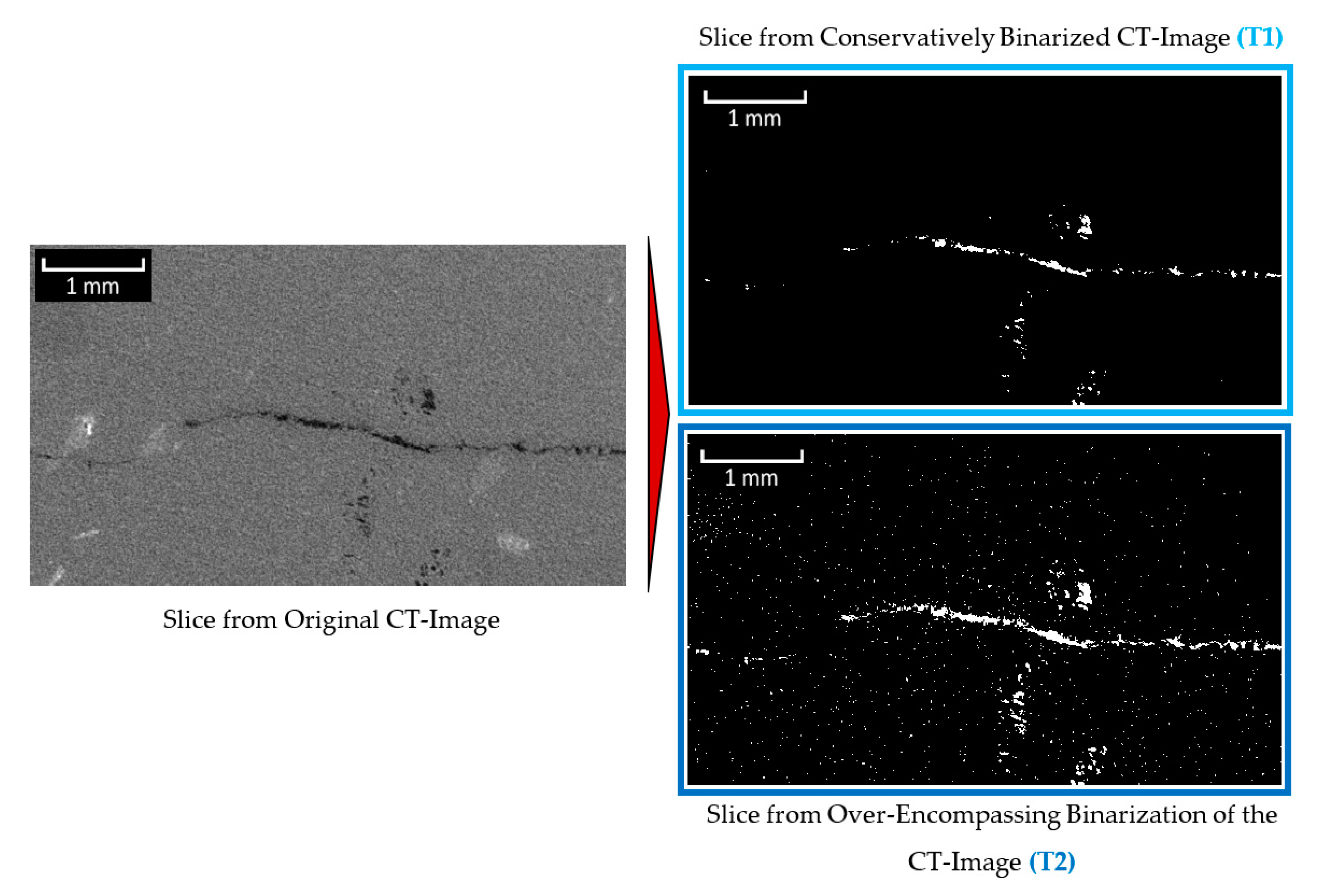
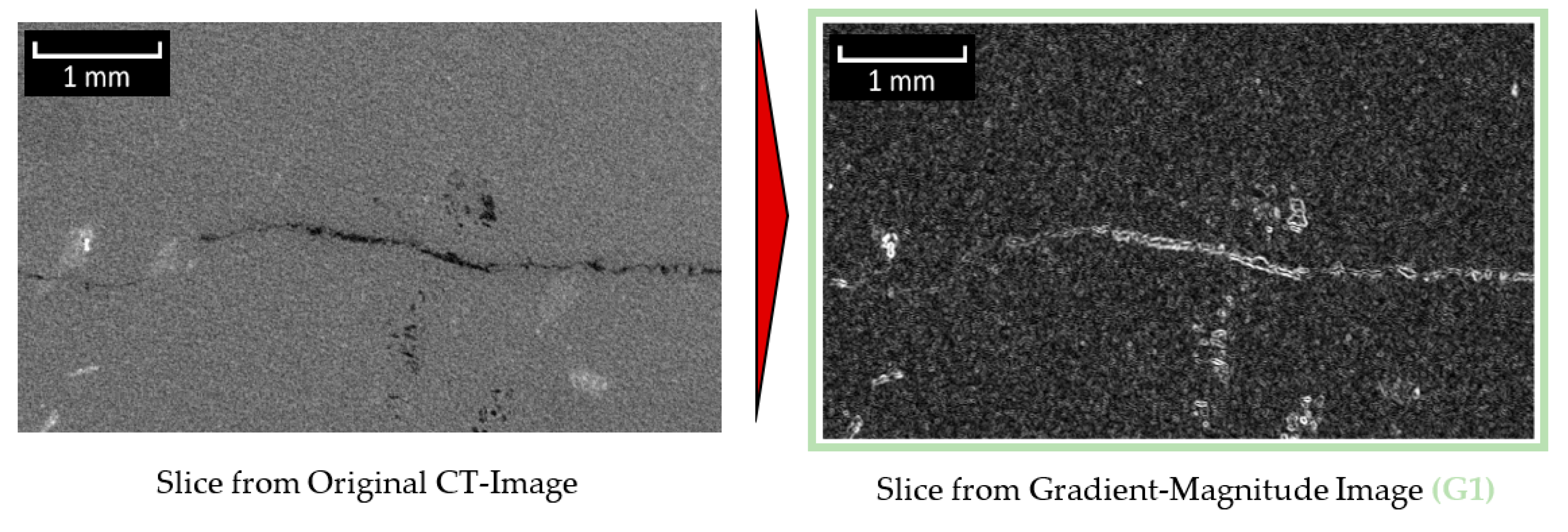
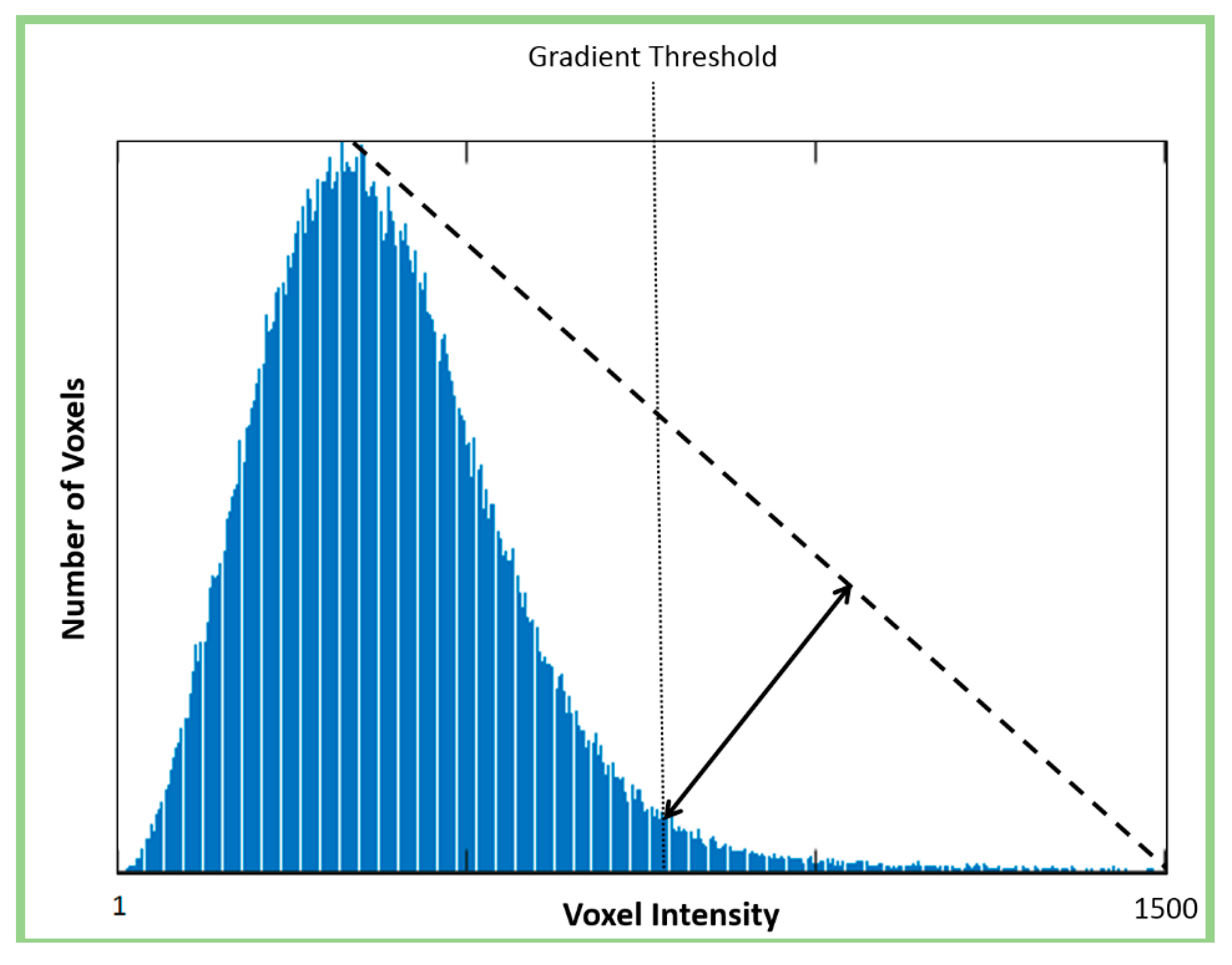


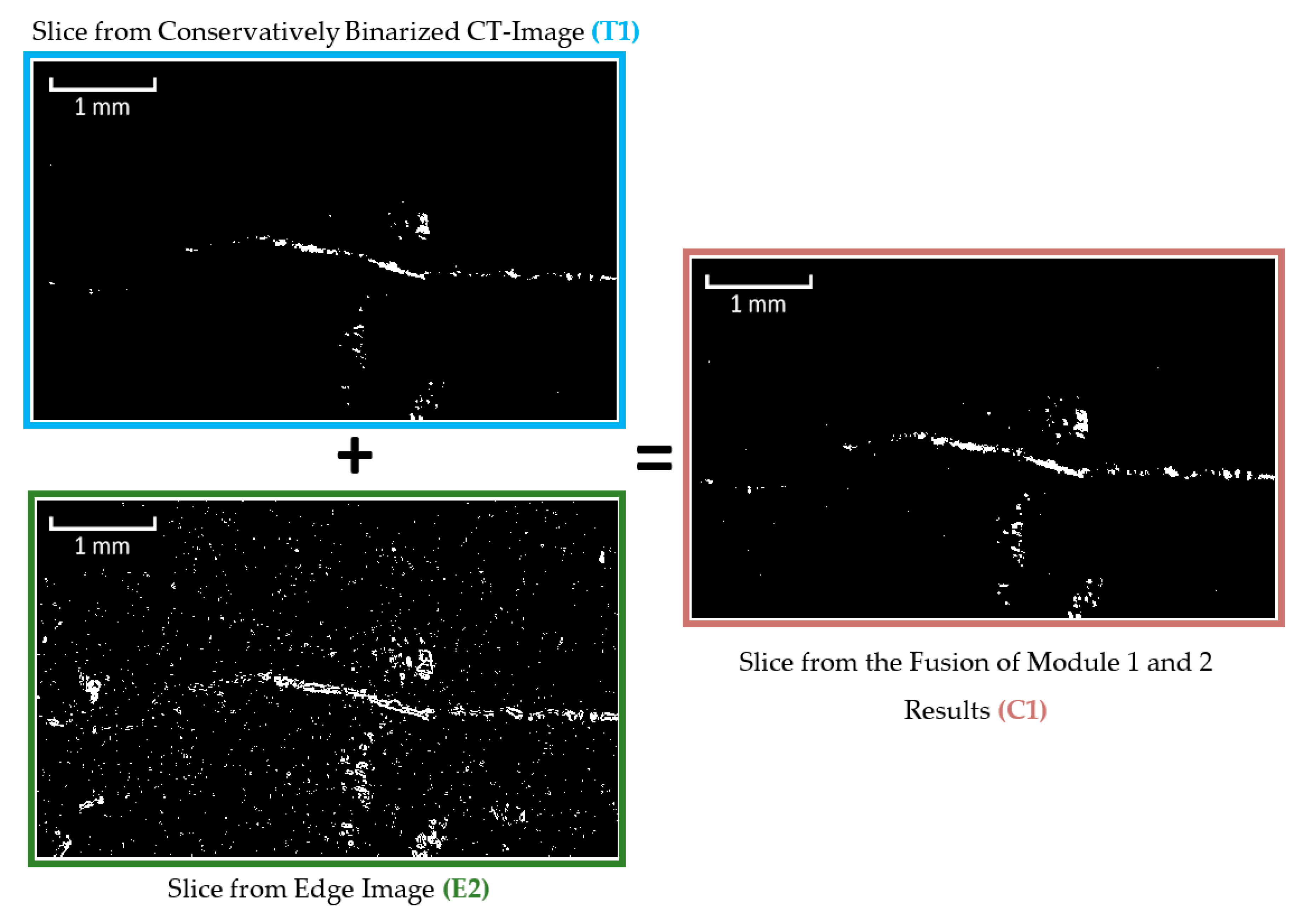
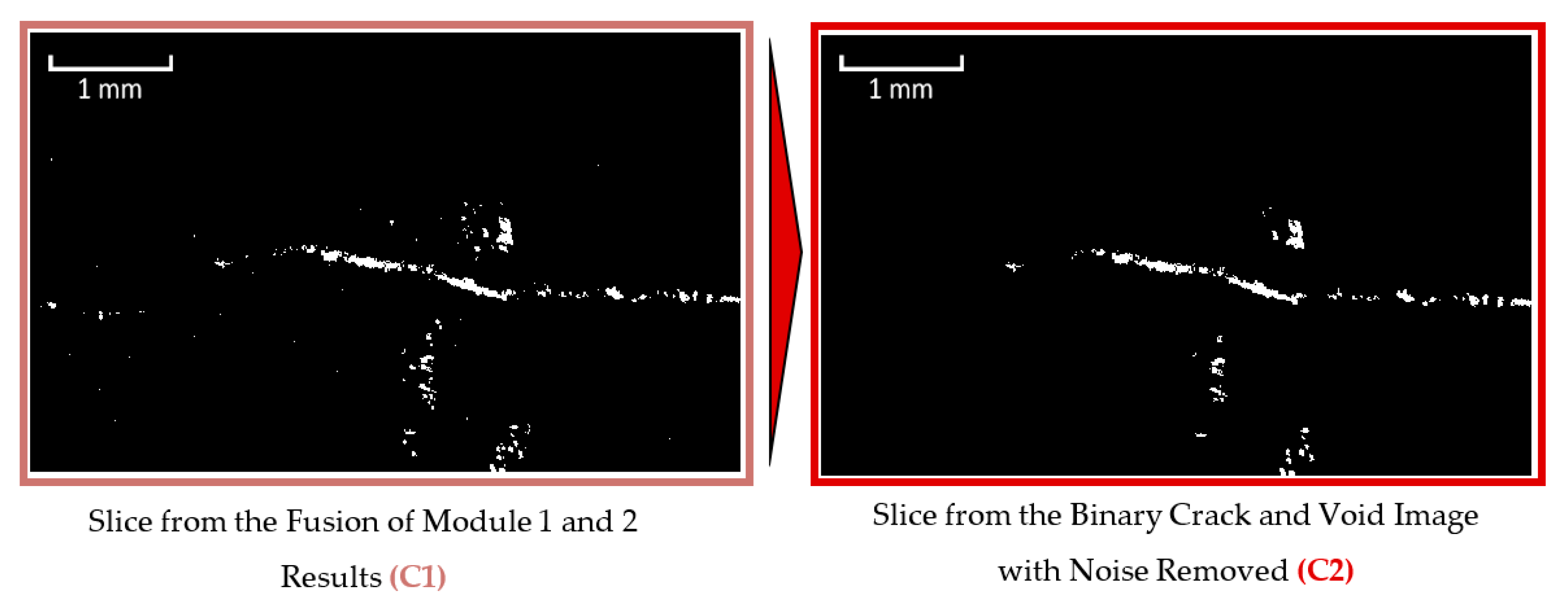
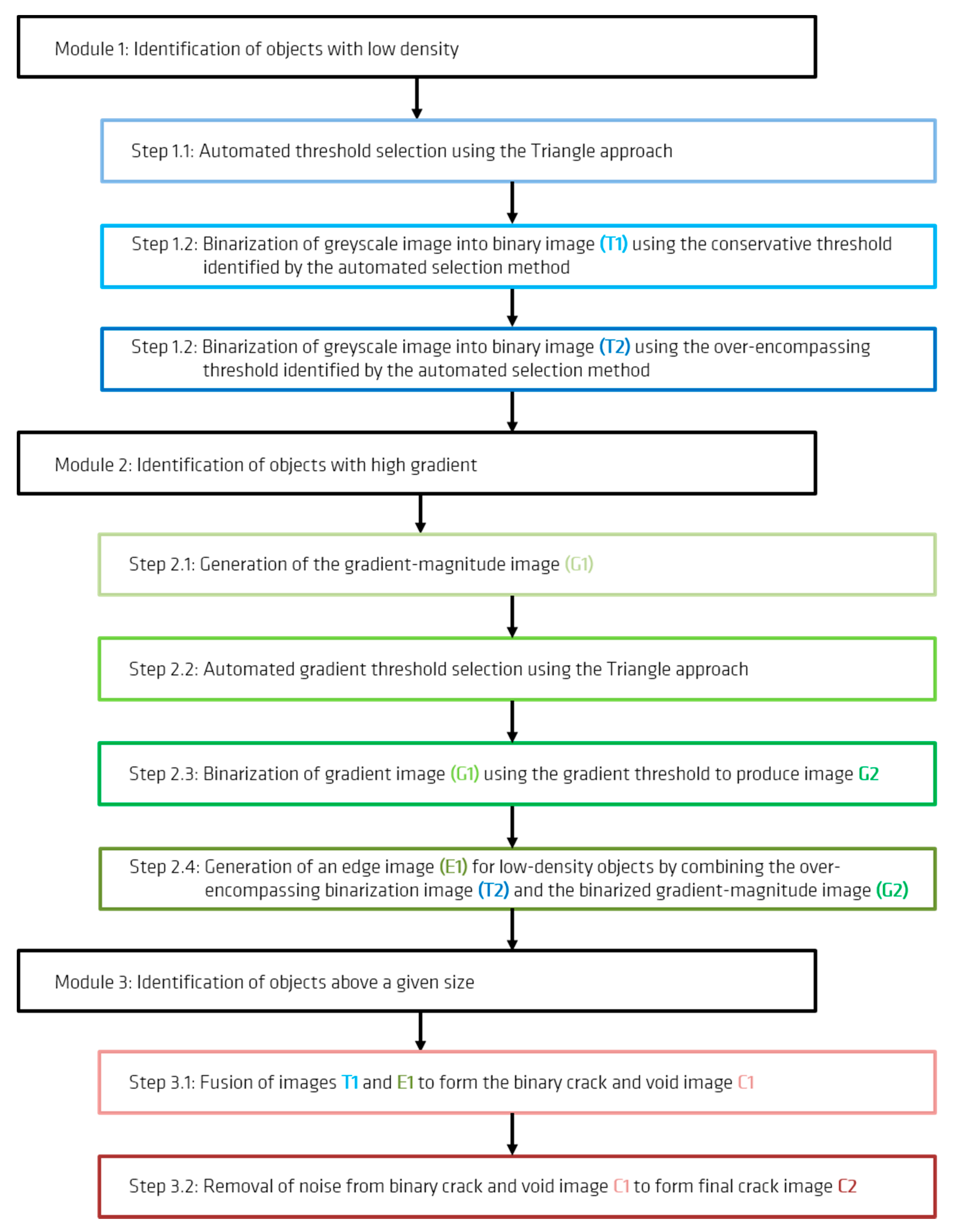

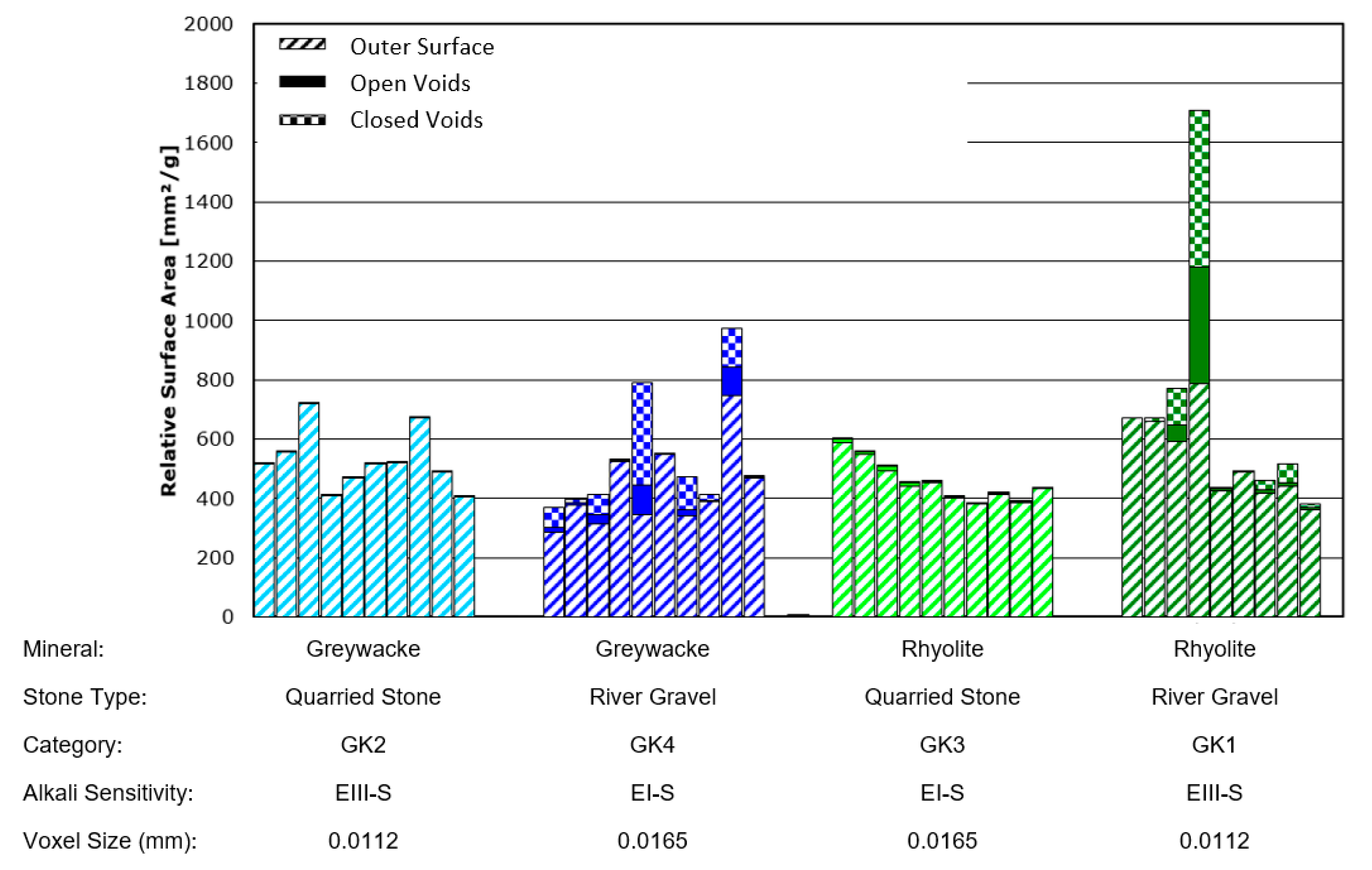
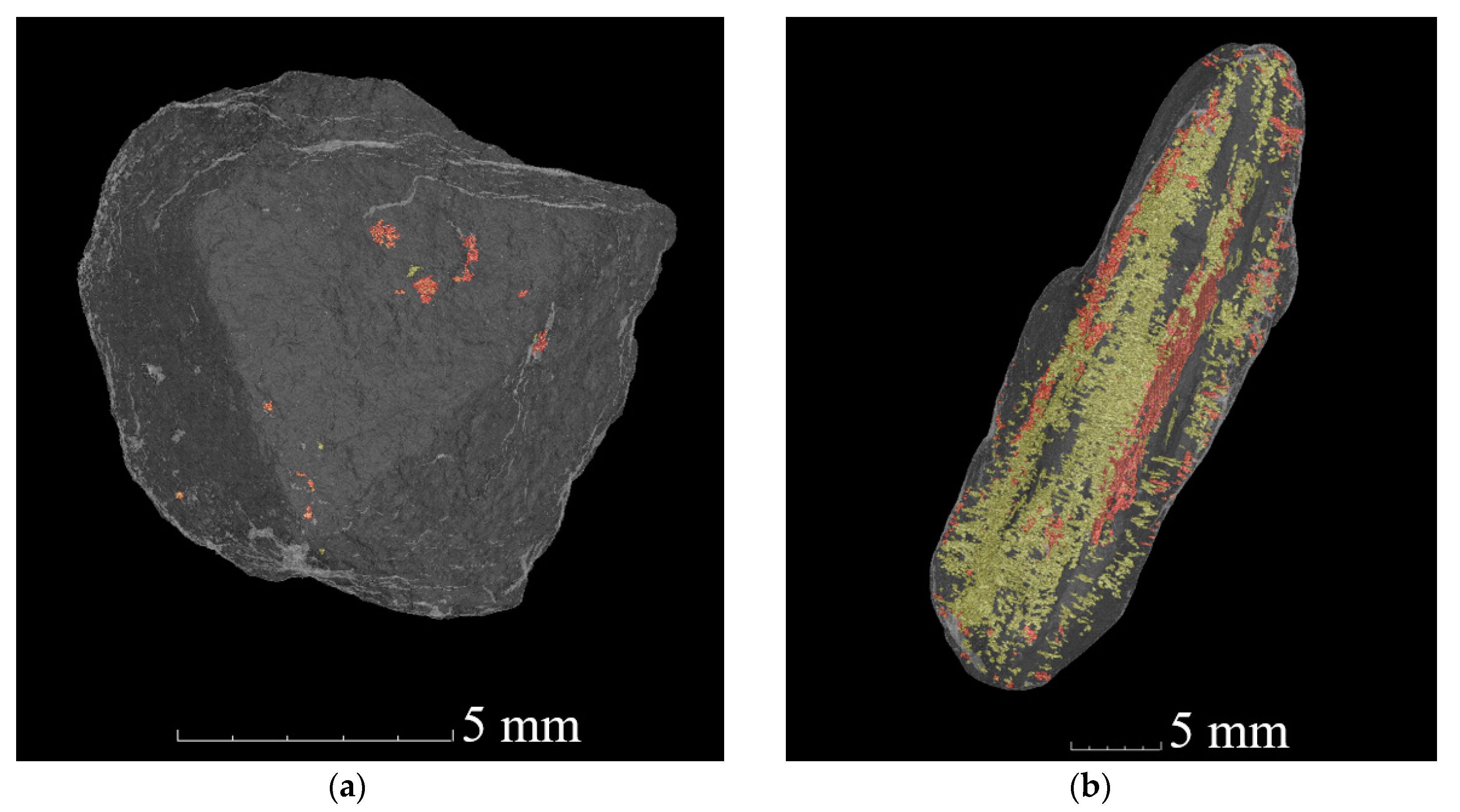
| Category | Stone Type | Alkali Sensitivity [40 °C-BV] |
|---|---|---|
| GK1 | River Gravel | EIII-S |
| GK2 | Quarried Stone (Greywacke) | EIII-S |
| GK3 | Quarried Stone (Rhyolite) | EI-S |
| GK4 | River Gravel | EI-S |
© 2020 by the authors. Licensee MDPI, Basel, Switzerland. This article is an open access article distributed under the terms and conditions of the Creative Commons Attribution (CC BY) license (http://creativecommons.org/licenses/by/4.0/).
Share and Cite
Oesch, T.; Weise, F.; Bruno, G. Detection and Quantification of Cracking in Concrete Aggregate through Virtual Data Fusion of X-Ray Computed Tomography Images. Materials 2020, 13, 3921. https://doi.org/10.3390/ma13183921
Oesch T, Weise F, Bruno G. Detection and Quantification of Cracking in Concrete Aggregate through Virtual Data Fusion of X-Ray Computed Tomography Images. Materials. 2020; 13(18):3921. https://doi.org/10.3390/ma13183921
Chicago/Turabian StyleOesch, Tyler, Frank Weise, and Giovanni Bruno. 2020. "Detection and Quantification of Cracking in Concrete Aggregate through Virtual Data Fusion of X-Ray Computed Tomography Images" Materials 13, no. 18: 3921. https://doi.org/10.3390/ma13183921
APA StyleOesch, T., Weise, F., & Bruno, G. (2020). Detection and Quantification of Cracking in Concrete Aggregate through Virtual Data Fusion of X-Ray Computed Tomography Images. Materials, 13(18), 3921. https://doi.org/10.3390/ma13183921






